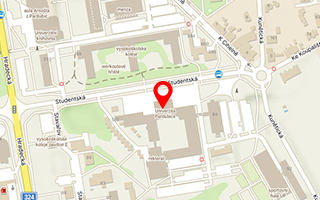Design of new shape of prestressed reinforced concrete beam
Provider: Technologická agentura České republiky
Programme: Program aplikovaného výzkumu, experimentálního vývoje a inovací GAMA
Implementation period: 01.07.17 - 31.08.19
Workplace:
Team member: Šmejda Aleš | Suchánek Vladimír
Description:
The newly designed beam is, unlike the contemporary beams, of a different technical solution and shape. The shape is trapezoidal with two nibs of dimensions 400 / 100 mm, which are located along the whole length of the beam. The length of the beam is proposed to span up to 28 m and it can vary concurrently with the height. The full end parts serve not only for the possibility of use of one anchor with higher prestress intensity, but for beam joints without cast end cross member, too. The intensity of prestressing can be easily changed. Longitudinal and cross beam alignment is presented in the particular project documentation. The beam is frame-shaped and the upper joint influential slab will be strengthened by a skew rib which will be created in the space between beams. The reinforcement of the slab along with the rib increases the general stiffness of the structure and this can be taken into account even in the static calculation by structure bearing capacity assessment. Considering the prestress in the end part of the beam as prestressed cable with cohesivness, and in the other parts as prestressed free cable protected from corrosion, there are some other options how to connect the bearing structure with the substructure into an integrated bridge, alternatively, how to use the pre-cast structures for bridges with more spans. The beam will be a valuable asset in bridge construction industry based on a thoroughly prepared documentation describing the materials of which the beam consists (reinforcement drawings, drawing of prestressing, anchor and stressing), the structural calculation documentation using the Scia Engineer and Atena software, including the suitable bridge accessories recommendation which can be used by the building company at the bridge construction with the designed elements. The documentation would contain other auxiliary data about bearing limits, skewness, or data about influence areas and deflection of the bridge made of the beams.
The newly designed beam is, unlike the contemporary beams, of a different technical solution and shape. The shape is trapezoidal with two nibs of dimensions 400 / 100 mm, which are located along the whole length of the beam. The length of the beam is proposed to span up to 28 m and it can vary concurrently with the height. The full end parts serve not only for the possibility of use of one anchor with higher prestress intensity, but for beam joints without cast end cross member, too. The intensity of prestressing can be easily changed. Longitudinal and cross beam alignment is presented in the particular project documentation. The beam is frame-shaped and the upper joint influential slab will be strengthened by a skew rib which will be created in the space between beams. The reinforcement of the slab along with the rib increases the general stiffness of the structure and this can be taken into account even in the static calculation by structure bearing capacity assessment. Considering the prestress in the end part of the beam as prestressed cable with cohesivness, and in the other parts as prestressed free cable protected from corrosion, there are some other options how to connect the bearing structure with the substructure into an integrated bridge, alternatively, how to use the pre-cast structures for bridges with more spans. The beam will be a valuable asset in bridge construction industry based on a thoroughly prepared documentation describing the materials of which the beam consists (reinforcement drawings, drawing of prestressing, anchor and stressing), the structural calculation documentation using the Scia Engineer and Atena software, including the suitable bridge accessories recommendation which can be used by the building company at the bridge construction with the designed elements. The documentation would contain other auxiliary data about bearing limits, skewness, or data about influence areas and deflection of the bridge made of the beams.
